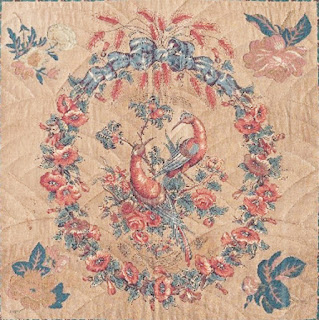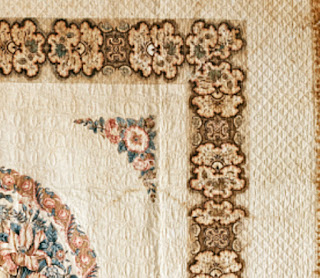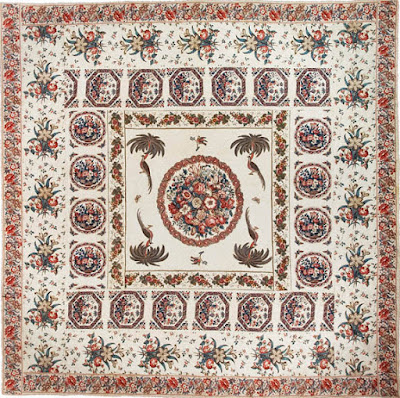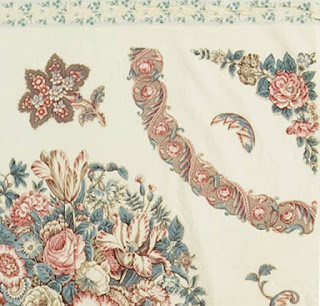Panel #11
Pair of birds with wheat in an oval floral frame.
Collection of the Smithsonian
Their caption tells us that it's probably English, "block printed in red, tan, dull yellow, and black on a white ground, with blue added by surface roller."
Their panel is framed with a pieced stripe in similar colors.
The birds in this panel are a bit awkward and the harsh shading on their necks does not add to their appeal. More pleasing is the drawing of the wheat above and the wreath of flowers that might be hardy hibiscus...
in a wreath similar to the one in Panel #3, the round trophy panel, another panel seen often in American quilts. We have photos of #11 in two different colorways, one with a white background and one with tan.
The tan seems to have been printed in a more limited range of colors, pinks, reds and blues.
Tan version from a Philadelphia quilt dated 1843-1847.
The corner images here might be added with Broderie Perse techniques. The panel looks to
have empty corners.
This quilt in the collection of Philadelphia's Arch Street Quaker Meeting
includes a combination of typical Philadelphia pieced and chintz appliqued blocks.
From a Kerry Taylor auction in London
We have only one example of a quilt located in Great Britain, which makes us think the bird fabric was primarily for export.
The brown ground can be hard to use.
The point of the Broderie-Perse technique
is to find a chintz and a background of the same shade.
Chintz bedcover from the Walker family
Charleston Museum.
The fruit panel (#5) is the focus with four birds in the corners. Note a little of the wheat motif has been added to each vignette next to the palm trees.
In this one we get a nice view of the repeat in a basket panel, the
only example so far we have seen of this fruit basket in a floral wreath.
Mary Alma Parker donated this medallion found
in an attic on Ladson Street with the entire panel in the center.
Attic storage would explain the heat-related deterioration.
Panel #3 in the center, long-necked birds in the corners
Charleston Museum (HT-576), published in the Orlofsky's
Quilts in America.
.
The large ring is assembled from pieces of panel #2.
See the last post.
UPDATE: Merikay found a better picture of the page.
In June, 1939 the Magazine Antiques published a photo of a classic Charleston-style bedcover attributed to Mrs. James Creswell. Owner Dr. Henry J. Berkley was a Maryland psychiatrist, an authority on antique furniture. The editor noted the bird panel in the center, a match to a quilt published two years earlier.
Magazine Antiques, October, 1937
This cover with cut out corners at the bottom and borders of piecework was attributed to the White family of Mt. Pleasant, South Carolina, perhaps to Sarah Hamlin White (1787-1842) buried in Cooks Old Field Cemetery in Charleston County. Having seen so many Charleston bedcovers, we were struck by the different style here. Although we do have photos of other Charleston quilts with cut-out corners---the typical New England format---this one seems a bit out of Charleston's context? Patchwork border strips are unusual in Carolina quilts, more labor intensive and something seen more often north of the North Carolina/Virginia border.
Bought at an auction in Georgia
This one with the brown bird panel was documented in the Quilts of Tennessee project. While many of these are so similar and so skillfully designed we suspect professional seamstresses and designers, The quilt above just doesn't have the panache of the Charleston examples. Note central panel #11 is rotated off center creating a rectangle.... Perhaps a copy of someone else's purchased bedcover?
Quilt attributed to Isabella Green Brewer, North Carolina
Found in Texas and pictured in the book Texas Quilts: Texas Treasures.
This one also looks to be from the hand of an amateur. The birds are at the top with a halved wreath cut from #11 on either side.
The circular frames are probably cut from other panels.
We've tried making chintz applique and it is not as easy as it looks.
Composition and placement can definitely get away from you.
On the subject of composition, the panel is found in at least three blocks in an extremely graceful Charleston album.
Quilt dated 1844-1845, Charleston Museum
Birds are cut from the panel in a block in the Banks-Eason album, made to celebrate a marriage in Charleston. The inked name is Henry Eason Dotterer, infant nephew of groom James Monroe Eason. The yellow in the birds is still bright in this photo.
The name of the groom himself is in the center, the wreath assembled from
Panel #11's frame.
Leftovers from the frame were used in Elizabeth Drummond's block. The bow is turned upside down. The remaining panel scraps, the top of the bow and the small palm trees, might have been used in other blocks.
https://ia800305.us.archive.org/2/items/1840sEasonBanksFamilyQuilt_201504/1840s%20Eason-Banks%20Family%20Quilt.pdf
What Have We Learned From Panel #11?
The more we look closely at these quilts the more we see a Charleston style---typical of a general Southern style of applique medallion. The Arch Street Meeting album at the top is a great example of medallion design that does not fit Charleston aesthetics. Charleston style includes a more economical use of fabric: large pieces of the florals, stripes and panels. Also economical in the sense of an economy of handwork and a good deal of white space. The chintzes, the placement and the composition make the bedcover.
Panel 11 with Panel #7 at top and Panel #13 on the bottom.
All of which makes us guess that this small top sold by a New England dealer in an online auction several years ago is probably not Southern.
See quilts at the Charleston Museum at these links:
The Banks/Eason Album
http://lcdl.library.cofc.edu/lcdl/catalog/lcdl:89298
The Ladson Street quilt:
http://lcdl.library.cofc.edu/lcdl/catalog/lcdl:89317
Medallion HT 576
http://lcdl.library.cofc.edu/lcdl/catalog/lcdl:89314



























































































